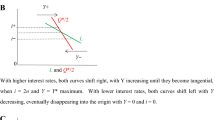Abstract
When extraction from mineral deposits is constrained byfixed capacity, an r-per-cent rule holds. This deposit-specific rule,however, is ``more partial'' than Hotelling's rule in that it is followed byprice takers and does not require price to adjust to produce equilibrium. Toobtain the resource rent to which the rule applies, the shadow value ofcapacity must be subtracted from the usual net price, i.e., price lessshort-run marginal cost. But the shadow value of capacity cannot becalculated from common depreciation formulas; an alternative method ofcalculating the shadow values is derived. The shadow value of reserves maybe increasing in the level of initial reserves. If there are increasingreturns to installing capacity, the value of the resource is not equal tothe discounted resource rent.
Similar content being viewed by others
REFERENCES
Bradley, Paul G. (1985), ‘Has the “Economics of Exhaustible Resources” Advanced theEconomics of Mining?’ in A. D. Scott, ed., Progress in Natural Resource Economics. Oxford: Oxford University Press, pp. 317–329.
Brown, Gardner, Jr. (1985), ‘Comment’, in A.D. Scott, ed.,Progress in Natural Resource Economics. Oxford: Oxford University Press, pp. 329–333.
Cairns, Robert D. (1998a), ‘Sufficient Conditions for a Class of Investment Problem’, Journal of EconomicDynamics and Control 23(1), September, 55–69.
Cairns, Robert D. (1998b), ‘TheMicroeconomicsofMineral Extraction under Capacity Constraints’, Nonrenewable Resources 7(3), September, 233–244.
Cairns, Robert D. (2000), ‘Accounting for Resource Depletion: A Microeconomic Approach’, Review ofIncome and Wealth 46(1), March, 21–31.
Cairns, Robert D. and Graham A. Davis (1998), ‘OnUsing Current Information to Value Hard-rock Mineral Properties’, Review of Economics and Statistics LXXX(4), November, 658–663.
Cairns, Robert D. and Pierre Lasserre (1986), ‘Sectoral Supplyof Minerals of Varying Quality’, Scandinavian Journal of Economics 88, 605–626.
Cairns, Robert D.and Nguyen Van Quyen (1998), ‘Optimal Exploration for and Exploitation of Nonhomogeneous Mineral Deposits’,Journal of Environmental Economics and Management 35(2), March, 164–189.
Camm, Thomas W. (1991), ‘Simplified Cost Models for Prefeasibility Mineral Evaluations’, InformationCircular 9298, U.S. Department of the Interior, Washington D.C.
Campbell, Harry F. (1980), ‘TheEffect of Capital Intensity on the Optimal Rate of Extraction of a Mineral Deposit’, Canadian Journal of Economics 13(2), May, 349–356.
Crabbé, Phillippe J. (1982), ‘The Effect of Capital Intensity on theOptimal Rate of Extraction of a Mineral Deposit’, Canadian Journal of Economics 15(3), August, 534–541.
Davis, Graham A. (1996), ‘Option Premiums in Mineral Asset Pricing: Are They Important?” LandEconomics 92(2), May, 167–186.
Davis, Graham A. and David J. Moore (1998), ‘ValuingMineral Reserves when Capacity Constrains Production’, Economics Letters 60, 121–125.
ElSerafy, Salah (1989), ‘The Proper Calculation of Income from Depletable Natural Resources’, in Yosuf J. Ahmad, Salah El Serafy and Ernst Lutz, eds., Environmental Accounting for Sustainable Development. Washington D.C.: World Bank.
Farrow, Scott (1985), ‘Testing the Efficiency of Extraction from a StockResource’, Journal of Political Economy 93(3), 452–487.
Gentry, Donald W. and ThomasJ. O'Neil (1984), Mine Investment Analysis. New York: Society of Mining Engineers.
Gray, Lewis C.(1914), ‘Rent under the Assumption of Exhaustibility’, Quarterly Journal of Economics 28, 466–489.
Hartwick, John M., Murray C. Kemp and Ngo Van Long (1986), ‘Set-Up Costs and Theory of ExhaustibleResources’, Journal of Environmental Economics and Management 13, 212–224.
Hotelling, Harold(1931), ‘The Economics of Exhaustible Resources’, Journal of Political Economy 39, 137–175.
Lasserre, Pierre (1985a), ‘Exhaustible Resource Extraction with Capital’, in A.D. Scott, ed., Progress inNatural Resource Economics. Oxford: Oxford University Press.
Lasserre, Pierre (1985b), ‘Capacity Choiceby Mines’, Canadian Journal of Economics 18(4), November, 831–842.
Lozada, Gabriel (1993),'The Conservationist's Dilemma’, International Economic Review 34, 647–662.
Mase Westpac,Ltd. (1990), The Winning of Gold. London: Mase Westpac.
Miller, Merton H. and Charles W. Upton(1985), ‘A Test of the Hotelling Valuation Principle’, Journal of Political Economy 93, 1–25.
Moyen, Nathalie, Margaret Slade and Raman Uppal (1996), ‘Valuing Risk and Flexibility’, ResourcesPolicy 22(2), 63–74.
Lewis, Tracy (1985), ‘A Note on Mining with Investment in Capital’,Canadian Journal of Economics 18(3), August, 665–667.
Scott, Anthony D. (1967) ‘The Theoryof the Mine under Conditions of Certainty’, in M. Gaffney, ed., Extractive Resources and Taxation. Madison, WI: University of Wisconsin Press.
Solow, Robert M. (1974), ‘The Economics of Resources orthe Resources of Economics’, American Economic Review, May, 1–14.
Takayama, Akira (1974),Mathematical Economics. Hinsdale, IL: Dryden Press.
Young, Denise (1992), ‘Cost Specification andFirm Behaviour in a Hotelling Model of Resource Extraction’, Canadian Journal of Economics 25(1), February, 41–59.
Author information
Authors and Affiliations
Rights and permissions
About this article
Cite this article
Cairns, R.D. Capacity Choice and the Theory of the Mine. Environmental and Resource Economics 18, 129–148 (2001). https://doi.org/10.1023/A:1011114400536
Issue Date:
DOI: https://doi.org/10.1023/A:1011114400536




